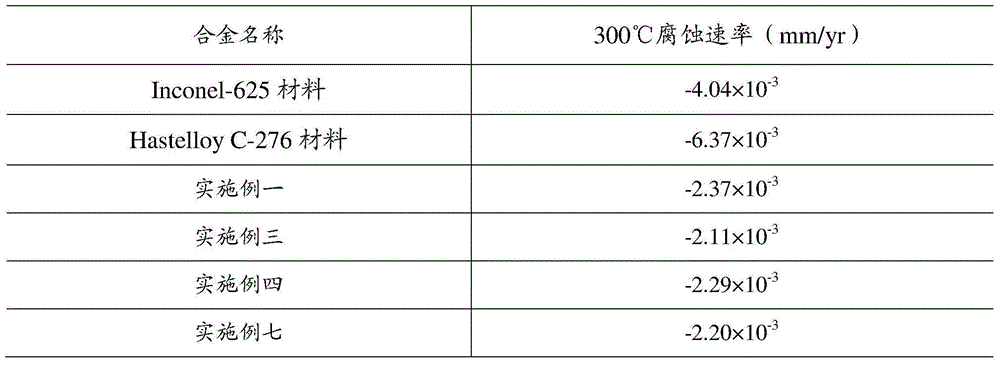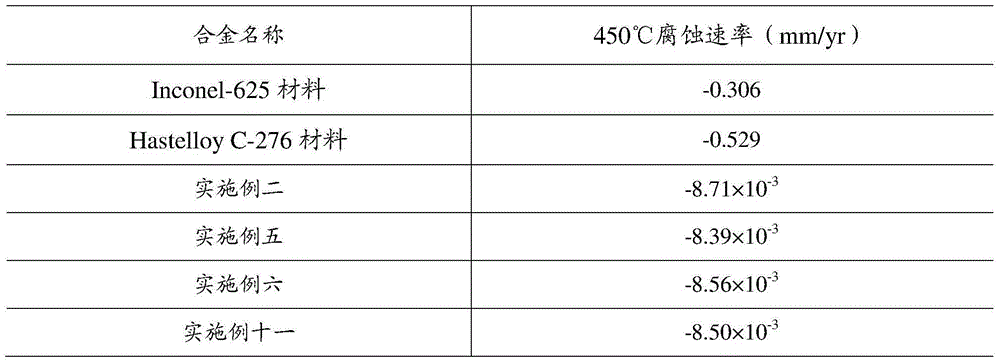Nickel-based alloy and preparation method and application thereof
A nickel-based alloy and alloy liquid technology, applied in the field of nickel-based alloys and their preparation, can solve problems such as poor corrosion resistance of supercritical equipment, achieve good oxidation resistance and thermal corrosion resistance, increase yield strength, and reduce stacking. The effect of stacking fault energy
- Summary
- Abstract
- Description
- Claims
- Application Information
AI Technical Summary
Problems solved by technology
Method used
Image
Examples
preparation example Construction
[0054] The present invention also provides a method for preparing the above-mentioned nickel-based alloy, comprising the following steps:
[0055] Step 1, take Ni, Cr, W, Mo, Al, Ti, Fe, trace element respectively, wherein, in terms of mass fraction, the mass fraction of Cr is 15%-28%, and the mass fraction of W is 4.1%-10% %, the mass fraction of Mo is 0.5%-4%, the mass fraction of Al is 0.8%-2.1%, the mass fraction of Ti is 0.3%-0.8%, the mass fraction of Fe is 6%-17%, the mass fraction of trace elements The fraction is 0-0.5%, and the balance is Ni. The mass fraction of C introduced by Ni, Cr, W, Mo, Al, Ti, Fe, and trace elements is greater than 0 and less than or equal to 0.03%;
[0056] Step 2, Ni, Cr, W, Mo, Fe are mixed and melted under vacuum conditions until cleared to obtain molten metal liquid after clearing;
[0057] Step 3: Refining the melted molten metal after refining, and cooling down until the surface of the obtained refining liquid freezes conjunctiva;
...
Embodiment 1
[0068] The nickel-based alloy provided in this embodiment includes Ni, Cr, W, Mo, Al, Ti, Fe, and C introduced by Ni, Cr, W, Mo, Al, Ti, Fe; wherein, in mass fraction, The mass fraction of Cr in the nickel-based alloy is 19.3%, the mass fraction of W is 4.1%, the mass fraction of Mo is 0.7%, the mass fraction of Al is 1.5%, the mass fraction of Ti is 0.6%, and the mass fraction of Fe is 12.9% %, the mass fraction of C is greater than 0 and less than or equal to 0.03%, and the balance is Ni.
[0069] The preparation method of the nickel-based alloy provided in this embodiment comprises the following steps:
[0070] Step 1, take Ni, Cr, W, Mo, Al, Ti, Fe respectively, wherein, by mass fraction, the mass fraction of Cr is 19.3%, the mass fraction of W is 4.1%, and the mass fraction of Mo is 0.7% , the mass fraction of Al is 1.5%, the mass fraction of Ti is 0.6%, the mass fraction of Fe is 12.9%, and the balance is Ni; the mass of C introduced by Ni, Cr, W, Mo, Al, Ti, Fe The sc...
Embodiment 2
[0076] The nickel-based alloy provided in this embodiment includes Ni, Cr, W, Mo, Al, Ti, Fe, and C introduced by Ni, Cr, W, Mo, Al, Ti, Fe; wherein, in mass fraction, The mass fraction of Cr in the nickel-based alloy is 16.2%, the mass fraction of W is 9.0%, the mass fraction of Mo is 2.5%, the mass fraction of Al is 1.9%, the mass fraction of Ti is 0.5%, and the mass fraction of Fe is 17.0% %, the mass fraction of C is greater than 0 and less than or equal to 0.03%, and the balance is Ni.
[0077] The preparation method of the nickel-based alloy provided in this embodiment comprises the following steps:
[0078] Step 1, take Ni, Cr, W, Mo, Al, Ti, Fe respectively, wherein, by mass fraction, the mass fraction of Cr is 16.2%, the mass fraction of W is 9.0%, and the mass fraction of Mo is 2.5% , the mass fraction of Al is 1.9%, the mass fraction of Ti is 0.5%, the mass fraction of Fe is 17.0%, and the balance is Ni; the mass of C introduced by Ni, Cr, W, Mo, Al, Ti, Fe The sc...
PUM
 Login to View More
Login to View More Abstract
Description
Claims
Application Information
 Login to View More
Login to View More - R&D
- Intellectual Property
- Life Sciences
- Materials
- Tech Scout
- Unparalleled Data Quality
- Higher Quality Content
- 60% Fewer Hallucinations
Browse by: Latest US Patents, China's latest patents, Technical Efficacy Thesaurus, Application Domain, Technology Topic, Popular Technical Reports.
© 2025 PatSnap. All rights reserved.Legal|Privacy policy|Modern Slavery Act Transparency Statement|Sitemap|About US| Contact US: help@patsnap.com


